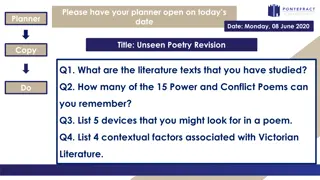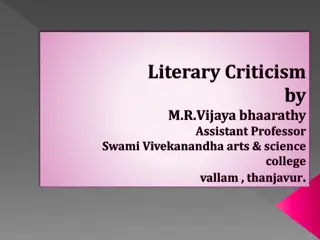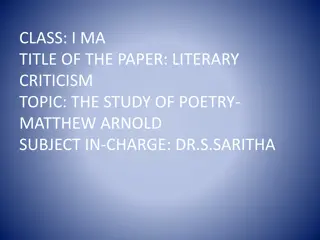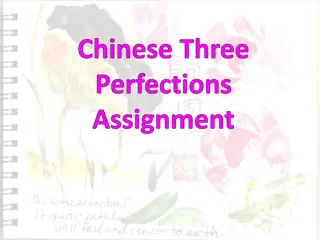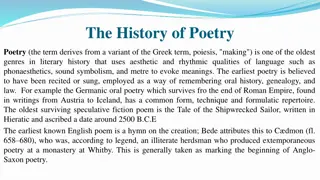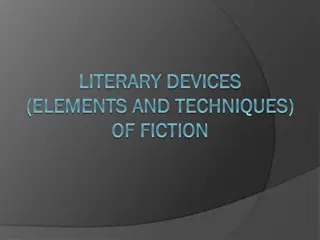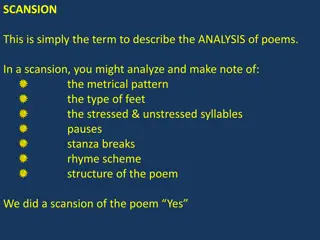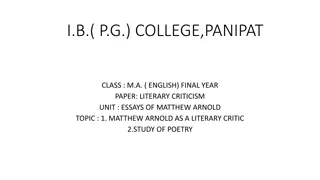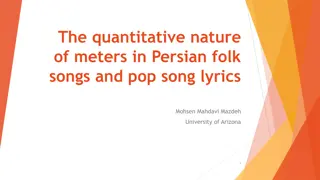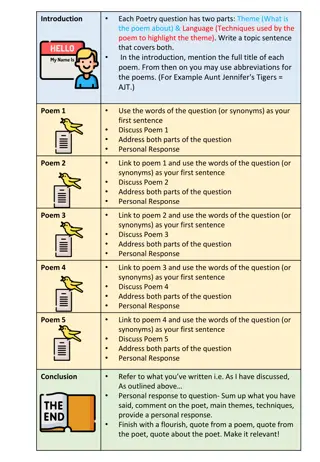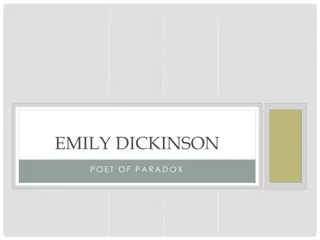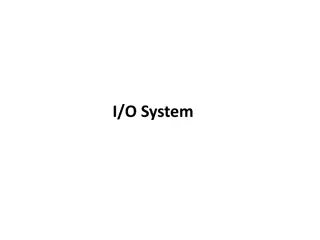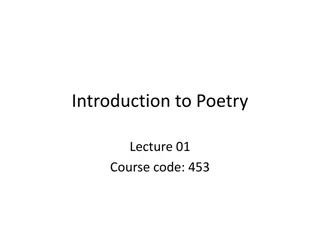Elements of Poetry: Understanding Literary Devices and Forms
Explore various elements of poetry, including alliteration, approximate rhyme, assonance, end rhyme, figurative language, folk ballads, imagery, imaginative language, internal rhyme, literary ballads, and lyrical poetry. Discover how these components enhance the depth and beauty of poetic expression through examples and explanations.
Uploaded on Sep 17, 2024 | 2 Views
Download Presentation

Please find below an Image/Link to download the presentation.
The content on the website is provided AS IS for your information and personal use only. It may not be sold, licensed, or shared on other websites without obtaining consent from the author.If you encounter any issues during the download, it is possible that the publisher has removed the file from their server.
You are allowed to download the files provided on this website for personal or commercial use, subject to the condition that they are used lawfully. All files are the property of their respective owners.
The content on the website is provided AS IS for your information and personal use only. It may not be sold, licensed, or shared on other websites without obtaining consent from the author.
E N D
Presentation Transcript
Alliteration The repetition of initial identical consonant sounds. Example: Homesick for home Daedalus hated Crete
Approximate Rhyme Sounds are similar but not exact.
Assonance The repetition of vowel sounds. Example: My words like silent raindrops fell All looked up in absolute amazement
End Rhyme Rhymes that occur at the end of a line of poetry.
Figurative Language Figurative language is language that uses words or expressions with a meaning that is different from the literal interpretation. Figurative language, in comparison, uses exaggerations or alterations to make a particular linguistic point. Figurative language is very common in poetry, but is also used in prose and nonfiction writing as well. http://grammar.yourdictionary.com/style-and-usage/Figurative-Language.html
Folk Ballad Poem passed by word of mouth from one generation to another. Blues music can find its roots in folk ballads that were often sung. Folk ballads often reflect elements region and culture.
imagery Language that appeals to the senses. Preludes by T. S. Eliot. The winter evening settles down With smell of steaks in passageways. Six o'clock. The burnt-out ends of smoky days. And now a gusty shower wraps The grimy scraps Of withered leaves about your feet And newspapers from vacant lots; The showers beat On broken blinds and chimney-pots, And at the corner of the street A lonely cab-horse steams and stamps. And then the lighting of the lamps.
Imaginative Language Words use to arouse the reader s feelings.
Internal Rhyme Rhyming within a line.
Literary Ballad Imitates the form and spirit of a folk ballad.
Lyrical Poetry Poetry in which the speaker reveals personal thoughts and feelings.
Metaphor Figure of speech that makes a comparison between two unlike things, in which one thing becomes another thing without the use of the word like, as, than or resembles.
Narrative Poetry Poetry that tells a story, has a plot and characters.
Onomotopoeia The use of a word or phrase that actually imitates or suggests the sound of what it describes. Examples: Snap Crackle Pop Buzz Sizzle
Parallelism Repeating of phrases/sentences so that the repeated parts are alike.
Personification Kind of metaphor in which a nonhuman thing or quality is talked about as if it were human.
Poetic Speaker The voice of a poem.
Repetition The repeating of sounds, letters, words, or lines, which helps give poetry its meaning, form and sound.
Rhyme Scheme The pattern of rhymes formed by the end rhyme in a poem. The Outlook wasn't brilliant for the Mudville nine that day: (a) The score stood four to two, with but one inning more to play. (a) And then when Cooney died at first, and Barrows did the same, (b) A sickly silence fell upon the patrons of the game. (b)
Rhythm Rhythm is a musical quality produced by the repetition of stressed and unstressed syllables. Rhythm occurs in all forms of language, both written and spoken, but is particularly important in poetry
Sensory Language Language that appeals to the senses and represents concrete objects, people, or events.
Simile A comparison of two dissimilar things using "like" or "as. For example: My love is like a red, red rose"





